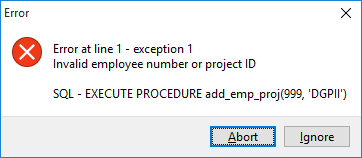InterBase Quick Start: Part V - Creating a Simple Executable Procedure
Go Up to InterBase Quick Start: Part V - Advanced Topics
Contents
 Creating a Simple Executable Procedure
Creating a Simple Executable Procedure
- The executable procedure that you create in this exercise,
add_emp_proj, makes use of an exception that you define withCREATE EXCEPTION. Execute the following statement to create theUNKNOWN_EMP_IDexception:You can now raise this exception in a trigger or stored procedure with theCREATE EXCEPTION unknown_emp_id 'Invalid employee number or project ID.'
EXCEPTIONclause. The calling application then receives the associated error message. - Execute the following statement to create the
add_emp_projstored procedure:This procedure takes an employee number and project ID as input parameters and adds the employee to the specified project using anCREATE PROCEDURE ADD_EMP_PROJ (v_empno SMALLINT, v_projid CHAR(5)) AS BEGIN INSERT INTO employee_project (emp_no, proj_id) VALUES (:v_empno, :v_projid); WHEN SQLCODE -530 DO EXCEPTION unknown_emp_id; END
INSERTstatement. The error-handlingWHENstatement checks forSQLCODE -530(violation of foreign key constraint) and raises the previously-defined exception if necessary. - To test the procedure, first enter the following statement:
SELECT * FROM employee_project WHERE emp_no = 20
The employee
20is assigned only to projectGUIDE.The image below shows the expected result:
- You can run this procedure by executing the following statement:
EXECUTE PROCEDURE add_emp_proj(20, 'DGPII')
- To confirm that it worked, execute the following
SELECTstatement:SELECT * FROM employee_project WHERE emp_no = 20
You can see that employee
20is now assigned to bothDGPIIandGUIDEprojects.The image below shows the expected result:
- Now try adding a non-existent employee to a project:
EXECUTE PROCEDURE add_emp_proj(999, 'DGPII')
The statement fails and the exception message displays on the screen.
Recursive Procedures
Stored procedures support recursion. Recursion is a powerful programming technique that is useful in performing repetitive tasks across hierarchical structures such as corporate organizations or mechanical parts.
 Creating a Recursive Procedure
Creating a Recursive Procedure
In this exercise, you create a stored procedure called dept_budget that takes a department number as an input parameter and returns the budget of a department and all departments that are under it in the corporate hierarchy. This procedure also uses local variables declared with DECLARE VARIABLE statements.
- Execute the following SQL statement:
CREATE PROCEDURE dept_budget (v_dno CHAR(3)) returns (total_budget NUMERIC(15, 2)) AS DECLARE variable sumb DECIMAL(12, 2); DECLARE variable rdno CHAR(3); DECLARE variable cnt INTEGER; BEGIN total_budget = 0; SELECT budget FROM department WHERE dept_no = :v_dno INTO :total_budget; SELECT count(budget) FROM department WHERE head_dept = :v_dno INTO :cnt; IF (cnt = 0) THEN suspend; FOR SELECT dept_no FROM department WHERE head_dept = :v_dno INTO :rdno DO BEGIN EXECUTE PROCEDURE dept_budget :rdno returning_values :sumb; total_budget = total_budget + sumb; END END
First, the procedure retrieves the budget of the department from the
Departmenttable, specified as the input parameter, and stores it in thetotal_budgetvariable. Then it retrieves the number of departments reporting to that department using theCOUNTaggregate function. If there are no reporting departments, it returns the value oftotal_budgetwithSUSPEND. Using aFOR SELECT … DOloop, the procedure then retrieves the department number of each reporting department into the local variablerdno, and then recursively calls itself with the following statement:EXECUTE PROCEDURE dept_budget :rdno returning_values :sumb
This statement executes
dept_budgetwith input parameterrdno, and inserts the output value insumb. When you useEXECUTE PROCEDUREwithin a procedure, you do not put the input parameters in parenthesis, and the variable and you specify the variable for the output value after theRETURNING_VALUESkeyword. - To find the total budget for the department
620, including all its subdepartments, execute the following statement:EXECUTE PROCEDURE dept_budget(620)
The result is:
About Data Type Conversion
The definition of the dept_budget procedure takes CHAR(3) as its input parameter. Because of InterBase automatic type conversion, you can actually provide an integer and that integer is converted. However, there are certain limitations. For example, you cannot provide an integer 000 because the conversion to CHAR(3) results in a string '0', which is not a valid department number. To test this, execute the procedure and specify the parameter as an integer 000 and then again as a string '000'.
More Procedures
There are a number of other procedures, some quite complex, defined in PROCS.SQL script. Now that you have a basic understanding of procedures, we recommend that you take some time to examine them and try using them. The PROCS.SQL script has many inline comments to make it easier for you to understand the code.
Conclusion
This completes the InterBase Quick Start tutorial. See InterBase User Guides for more guides and tutorials.



